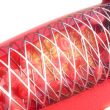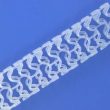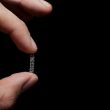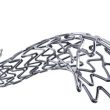Courtesy of Dr. Carlos Fava. Nowadays, chronic total occlusions (CTO) due to in-stent restenosis (ISR) represent 5%-25% of all coronary angioplasties. These lesions pose a new and true challenge, since CTOs are often associated with stent-related problems (fractures, lack of expansion, overlapping, deformation), extreme tortuosity, severe calcification, tandem lesions after CTO, and aorto-ostial lesions, with little<a href="https://solaci.org/en/2017/06/26/success-in-ctos-caused-by-restenosis-lowers-cardiac-mortality/" title="Read more" >...</a>
The use of IVUS in unprotected left main PCI associated to better outcomes, compared to angiography guided PCI
Courtesy of Dr. Gustavo Leiva. Coronary Artery Bypass Graft (CABG) has traditionally been the procedure of choice in patients with left main coronary artery disease. However, the use of percutaneous techniques in this kind of lesions has been on the rise, partly due to recent research showing similar outcomes with both procedures. Unprotected left main<a href="https://solaci.org/en/2017/06/26/the-use-of-ivus-in-unprotected-left-main-pci-associated-to-better-outcomes-compared-to-angiography-guided-pci/" title="Read more" >...</a>
Transradial access shows no benefit of bivalirudin
The aim of this study was to compare bivalirudin against heparin in patients with ST elevation acute myocardial infarction undergoing transradial primary PCI. Both bivalirudin and the transradial access are strategies aimed at reducing bleeding complications in patients undergoing acute MI. However, the benefit of their combined use is not year clear. Even though<a href="https://solaci.org/en/2017/06/21/transradial-access-shows-no-benefit-of-bivalirudin/" title="Read more" >...</a>
Biodegradable-polymer stents are as safe as permanent-polymer stents in a 5-year follow-up
Courtesy of Dr. Carlos Fava. One of the questions around drug-eluting stents (DES) is whether the development of biodegradable polymers would derive in better outcomes than the performance of durable polymers as regards the presence of events. In consequence, the COMPARE II trial was carried out with the aim of testing them in “real-world” patients. This<a href="https://solaci.org/en/2017/06/13/biodegradable-polymer-stents-are-as-safe-as-permanent-polymer-stents-in-a-5-year-follow-up/" title="Read more" >...</a>
Leaders Free ACS: Good Results for the Polymer-Free Stent at 2 Years in ACS
Courtesy of the SBHCI. Guidelines recommend dual antiplatelet therapy for a year in patients admitted with coronary acute syndrome. However, patients at high risk for bleeding who receive coronary angioplasty have been historically excluded from studies. The new polymer-free stent BioFreedom allows for the reduction of dual antiplatelet therapy time, due to rapid drug elution<a href="https://solaci.org/en/2017/05/30/leaders-free-acs-good-results-for-the-polymer-free-stent-at-2-years-in-acs/" title="Read more" >...</a>
EVOLVE II: Diabetes Substudy: Results at 3 Years after the SYNERGY Stent in Diabetics
Courtesy of SBHCI Diabetic patients have worse evolution after coronary PCI. Drug eluting stents with bioresorbable polymers were designed to facilitate arterial healing, and reduce inflammation and late and very late thrombosis risk. This sub-study of diabetic EVOLVE II patients presents the 3 year outcomes of the SYNERGY stent. The EVOLVE II included<a href="https://solaci.org/en/2017/05/25/evolve-ii-diabetes-substudy-results-at-3-years-after-the-synergy-stent-in-diabetics/" title="Read more" >...</a>
ARTE: Aspirin or Aspirin and Clopidogrel after TAVR?
Courtesy of SBHCI. This study presented at Euro PCR and simultaneously published by JACC Cardiovascular Interventions poses a question that has remained unanswered since the start of TAVR. There is little information on the optimal antithrombotic therapy after transcatheter aortic valve replacement (TAVR). In general, patients receive between 1 and 6 months of dual<a href="https://solaci.org/en/2017/05/25/arte-aspirin-or-aspirin-and-clopidogrel-after-tavr/" title="Read more" >...</a>
Second-Generation DES Present Lower Mortality Rates for Vein Grafts
Courtesy of Dr. Carlos Fava. The treatment of vein graft lesions has always been difficult in relation to angioplasty, due to their characteristics. While drug-eluting stents (DES) have proven to be superior to bare-metal stents (BMS) for coronary arteries, such superiority is unclear as regards vein grafts. Several studies with first-generation DES (DES1) have even reported<a href="https://solaci.org/en/2017/05/24/second-generation-des-present-lower-mortality-rates-for-vein-grafts/" title="Read more" >...</a>
DESSOLVE III: Xience vs. MiStent
The MiStent device is made of cobalt-chromium, with struts of up to 64 µm thick. It is coated with a completely absorbable polymer that contains a microcrystalline form of sirolimus that embeds directly into the vessel wall. The drug is eluted continuously for up to 9 months. This was a multicenter noninferiority study that randomized patients<a href="https://solaci.org/en/2017/05/23/dessolve-iii-xience-vs-mistent-3/" title="Read more" >...</a>
Promising Outcomes of Overlapping Stents in Patients Undergoing Bioresorbable Scaffold (BRS) Implantation
Courtesy of Dr. Guillermo Migliaro. In regular clinical practice, overlapping stents are reported in up to 30% of patients undergoing coronary angioplasty, especially due to very long lesions requiring implantation of multiple stents or dissection after the implantation of a first stent. In bare metal stent era, overlapping was associated with unfavorable clinical outcomes<a href="https://solaci.org/en/2017/05/08/promising-outcomes-of-overlapping-stents-in-patients-undergoing-bioresorbable-scaffold-brs-implantation/" title="Read more" >...</a>









